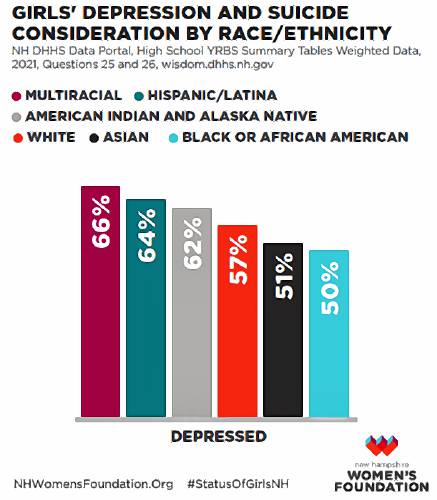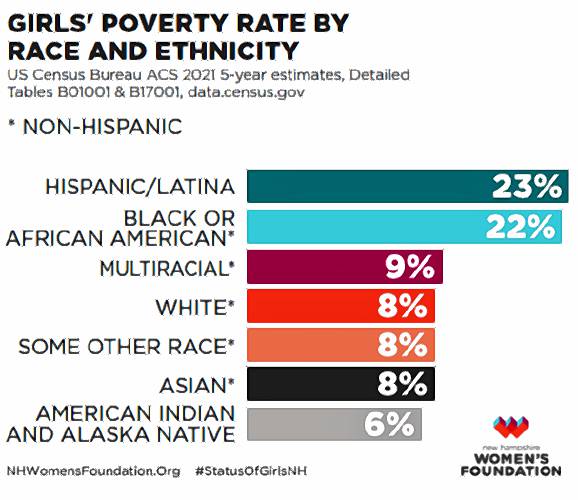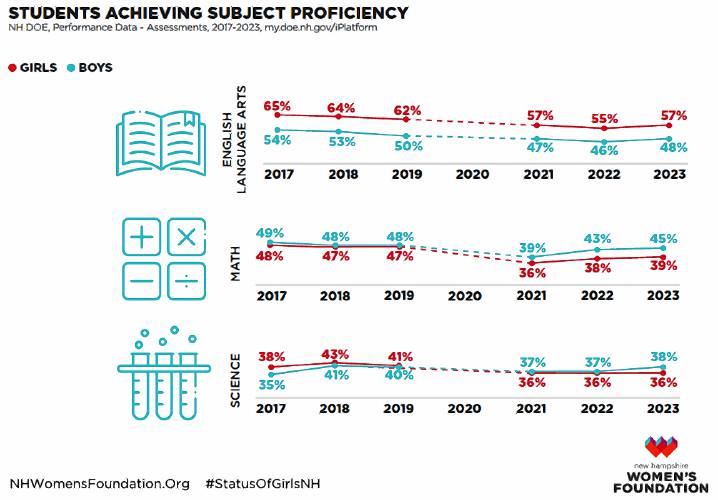Status of Girls: Higher rates of depression and poverty for New Hampshire girls of color
| Published: 06-25-2024 6:20 PM |
Riyah Patel knows the impact of the pandemic on high school girls. She was one when school shuttered and online classes began.
She saw the struggles with mental health, learning gaps and isolation in her classmates. She saw it continue as she returned to in-person classes too – having just graduated from high school last month.
The New Hampshire Women’s Foundation’s latest report, the Status of Girls in New Hampshire 2024 helps quantify what Patel saw. Student achievement in math, English and science is down. Rates of suicidal thoughts and depression among girls continue to grow – outpacing mental health statistics among boys. And for girls of color or those who identify within the LGBTQ community, these outcomes are exacerbated.
Patel, a Concord native, has been part of the solution, said Devan Quinn, the policy director for the Women’s Foundation. During the summer while the pandemic was in full force, Patel started tutoring nearly a dozen of New American students at the Concord public library. By fall, she founded New American Scholars, a nonprofit that connects a network of tutors to over 200 students statewide.
The data in the foundation’s latest report underscores the importance of the work that organizations like hers perform, said Patel.
“It allows us to effectively communicate the need for our programming to community members, policymakers, grantors and donors,” said Patel.
The New Hampshire Women’s Foundation has supported Patel’s New American Scholars with a Women and Girls of Color grant.
While New Hampshire has rapidly diversified since 2010 – with a 29 percent increase of girls of color in the state according to the report – these young women are more likely to live in poverty and experience higher rates of depression and suicidal thoughts.
Article continues after...
Yesterday's Most Read Articles
Poverty rates for girls who identify as Hispanic or Black are more than double that of their white peers – with rates at 23 percent, 22 percent and 8 percent, respectively.
Girls who identify as multiracial, Hispanic or American Indian also have the highest rates of depression in the state, according to the report.
“We often hear that New Hampshire is a great place to live and grow and it absolutely is for kids,” said Quinn. “But it’s so different when you look at it by race and ethnicity and by county.”
To better support communities of color, advocates need to continue to highlight that racial and ethnic disparities exist, often beyond what headlines about New Hampshire being a great place for kids say, she said.
Data shows that girls, though, are more likely to ask for help with mental health. Three out of four New Hampshire callers to Crisis Text Line identify as female, according to the report.
That is why policies like including the helplines for suicide prevention and the National Alliance for Eating Disorders on the back of student identification cards in the state are essential, said Quinn. This year,
“Girls do reach out when they have resources at their fingertips,” she said. “It’s such a great solution. We are not going to fix everything overnight but we can make progress and I’m so happy that those solutions were passed.”
While data collection helps explain realities for girls throughout the state, these results are limited to a gender binary, said Quinn.
To better be able to understand issues impacting all girls, data collection needs to be more inclusive about gender identity, sexual orientation and other demographics.
This year’s report shared that girls who identify with the LGBTQ community experience higher rates of depression and suicidal ideations.
“One of the most important things we can do is listen to girls, listen to their experiences and listen to what they want and need in their schools and in their communities,” said Quinn.










 ‘A little piece of everything I like’: New Pittsfield barbershop brings more than a haircut to downtown
‘A little piece of everything I like’: New Pittsfield barbershop brings more than a haircut to downtown NH judge decides to pause Trump’s birthright citizenship order
NH judge decides to pause Trump’s birthright citizenship order Canterbury honors ‘real heroes’ with updated Military Veterans’ Project
Canterbury honors ‘real heroes’ with updated Military Veterans’ Project Look, up in the sky! It’s… an Airstream trailer?
Look, up in the sky! It’s… an Airstream trailer?
